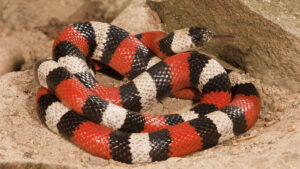Milk snakes are captivating reptiles known for their vibrant colors and sleek appearance. Often confused with the venomous coral snake due to their similar appearance, milk snakes are non-venomous and pose little threat to humans. However, like any snake, they have the ability to bite if they feel threatened or cornered. In this article, we will explore the question, “Do milk snakes bite?”
Yes, milk snakes can bite, but they are generally non-aggressive towards humans. Like most snakes, they may bite if they feel threatened, provoked, or cornered. However, their bites are not venomous and are usually harmless, causing minor discomfort at most.
It’s essential to handle milk snakes with care and respect to avoid stressing them, which could lead to defensive behavior like biting. If you encounter a milk snake in the wild or as a pet, it’s best to observe it from a distance and avoid provoking it to ensure a safe interaction for both you and the snake.
Do Milk Snakes Bite?

Milk snakes are non-venomous snakes that are generally docile and reluctant to bite. However, like any snake, they may bite if they feel threatened, provoked, or cornered. Their primary defense mechanism is to flee rather than fight, but if they are handled roughly or feel endangered, they may resort to biting as a last resort.
When threatened, a milk snake may exhibit defensive behaviors such as hissing, coiling, or vibrating its tail. These are warning signs that the snake is feeling stressed or agitated and may bite if further provoked.
It’s important to handle milk snakes and any other snakes gently and respectfully to minimize stress and reduce the risk of bites. If you encounter a milk snake in the wild or have one as a pet, give it space and avoid making sudden movements or loud noises that could startle it.
If you are bitten by a milk snake, it’s essential to clean the wound thoroughly with soap and water and monitor it for signs of infection. While milk snake bites are generally harmless and non-venomous, it’s always a good idea to seek medical attention if you have any concerns or if the bite becomes infected.


